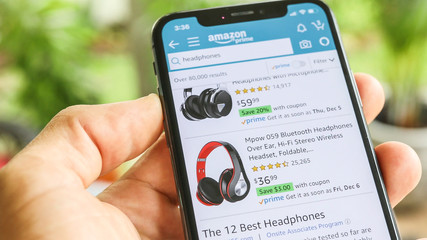
Amazon two-part product title restructures product listings with a short core product title and feature-rich highlights to support mobile shopping and AI search.
Product titles play a bigger role in conversions than most sellers realize. According to Salsify’s 2023 Shopper Research, over 70% of U.S. shoppers say the quality of product titles and descriptions directly influences their buying decisions.
That’s why recent reports of Amazon testing a new two-part product title format in April 2025 have caught the attention of serious sellers. While this update is not yet part of the confirmed January 2025 policy changes, its potential impact on Amazon listing performance and search visibility is significant.
For sellers looking to stay ahead, preparing now is the smartest move. Structuring your product titles to fit this new format could help your products perform better in mobile shopping and AI-powered search, two areas Amazon is prioritizing.
Major shift with two-part product Amazon product title format
Amazon is preparing to change how product titles appear on product detail pages, marking what could be the biggest structural update in years. Spencer Millerberg shared on LinkedIn that the new Amazon two-part product title format will split the product title field into two sections.
The first part will include a short and clear product title with essential product identifiers like brand, product type, and variation. The second part, labeled “Product Highlights,” is meant to showcase key features and benefits that help customers make informed decisions.
Millerberg emphasized this is more than a cosmetic change—it’s a data and visibility opportunity. He called it a “land grab,” especially for brands that move early.
Why now? According to Millerberg, the shift supports three major needs:
Over 70% of Amazon shoppers use mobile, where shorter product titles improve the buying experience.
Amazon’s AI tools, Cosmo and Rufus, rely on structured data to improve search and recommendations.
Review-based data isn’t enough. Amazon wants brands to feed accurate, prioritized product information directly.
Sellers should not treat this as a simple rewrite. Millerberg warned against wasting space on branding language and instead advised focusing on keywords and phrases that customers are already searching for.
With the rollout likely in Q2 or Q3, brands that prepare now will be in a stronger position to gain visibility and clicks. Late adopters may have to rely more on ads to catch up.
Pattern"Product titles are a critical factor in driving conversions because they influence consumers’ initial click to your listing from the Amazon search results page."
How this Amazon two-part product title format connects to January’s title requirements
The upcoming Amazon two-part product title format appears to build directly on the groundwork laid by the January 2025 product title policy update of maximum 200 characters. That earlier initiative aimed to reduce clutter and standardize how product titles are written across listings.
Amazon’s January title requirements focused on cutting down on excessive length, keyword stuffing, and misuse of special characters- elements that made product titles harder to read and less trustworthy. The new two-part product title requirements take that standardization a step further by structurally dividing product titles into distinct sections for clarity and mobile compatibility.
Both initiatives share a common purpose: improving the customer experience. While January’s policy forced sellers to trim the fat, the two-part structure now guides them on how to present what remains.
Part 1 will keep product titles short and to the point, reinforcing the policy’s character limits and avoiding repetition.
Part 2 allows for more structured detail using customer-relevant highlights—without reverting to the “word salad” tactics of the past.
Spencer Millerberg’s insight supports this evolution. He suggests that Amazon is prioritizing structured, high-quality data not just for shoppers, but to fuel its AI engines. That aligns with the January policy’s shift toward relevance over repetition.
In short, January’s restrictions cleaned up the playground. The two-part product title format tells sellers exactly how to play by the new rules.
Amazon two-part product title format could redefine how products compete for clicks
Steven Pope, our Amazon agency founder, shared his insights on how this will impact sellers, emphasizing the need for a measured approach. He noted Amazon’s long-standing desire for shorter product titles, but cautioned against immediate overhauls.
The Short and Long of It: The short product title may be limited to around 50 characters, while the long version might allow up to 150 characters. Final limits haven’t been announced yet, but Amazon is clearly aiming to streamline product listings.
Mobile May Hide Long product titles: The long version might not even display on mobile. That means sellers relying on longer product titles to convey product features could lose visibility where most shoppers browse.
Sellers are urged not to react too quickly. Steven advises waiting to optimize listings until Amazon fully implements the change before modifying listings. Premature updates can waste time and potentially harm Amazon SEO performance.
Amazon has floated character limits before, only to pull back weeks later. According to Steven, “If you knee-jerk every time Amazon sneezes, you’ll burn yourself out making changes that never stick.”
Brand names may also take a hit. Long or abstract brand names could suffer under this new format. “Short brand names will win,” Steven notes. “Most buyers don’t even remember the brand of their last Amazon purchase.”
Amazon-native sellers, those who don’t drive off-platform traffic, should take note. Since most customers associate products with Amazon rather than the brand itself, the focus should be on clear product value, not branding.
This change isn’t just about trimming Amazon titles. It could rewrite product listing best practices, shift how products rank, how customers engage, and ultimately, who makes the sale.
Product title guidelines no Amazon seller asked for
Noah Wickham, our Sales Director, shared additional insights about the update
According to Amazon, this change aims to enhance product visibility, improve customer experience, and provide a more flexible display depending on search behavior. But many sellers see it differently.
Wickham also pointed out that this change aligns with Amazon’s recent move to kill the “main image hack,” a popular tactic where sellers embedded keywords visually in their hero image to boost clickthrough. This new product title format appears to be Amazon’s way of reasserting control over how product information is displayed—at the cost of seller flexibility.
Noah Wickham, Sales Director at My Amazon Guy"Let’s be real—pictures are for people, text is for robots,” Wickham added. “Customers shop with their eyes. This feels like another change no one asked for."
While Amazon claims the shift will give sellers “full control” over how their listings stand out, the community remains skeptical. Other marketplaces have tried similar formats, with poor results.






